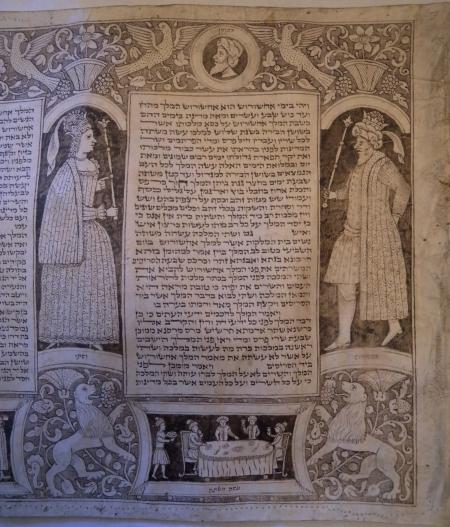Obj. ID: 34761
Hebrew Illuminated Manuscripts MAHJ Aryeh Leib ben Daniel of Goray Sepia Esther Scroll, Italy (?), 1740s

The scroll is not signed but its ornamentation executed solely in sepia ink resembles the style of the megillot Esther made by the artist-scribe Aryeh Leib son of Daniel of Goray (Pol. Goraj), Poland. The upper margins are lavishly decorated with medallions containing the busts of the minor characters of the Esther story (princes of Media and Persia and courtiers of the king) identified by their names written in a semi-cursive Hebrew script. They are flanked by birds facing back and these are alternated with baskets with flowers. The background behind the decorative details along all membranes is filled with a repeating composition of leafy tendrils and fruits. The text is inscribed in the rectangular panels interspersed by full-length figures of the Esther story protagonists standing in the niches that are also identified by their names inscribed in the same type of Hebrew script as above. The spaces below them are adorned with rectangles with shorter concave sides containing narrative scenes reflecting the Purim story; they are also captioned in semi-cursive Hebrew script. They are separated by repeating decorations composed of a lion and leafy tendrils with flowers and fruits; they are placed exactly below full-figure representations of the heroes. Additionally, the hand-drawn imitation of the cross-hatching fills the background in the upper margins and behind the lions in the lower margins. The busts, figures between the text panels, and the narrative scenes are shown against a dark background.
For an almost identical scroll see ID 39596.
Most likely the same ink was used for copying the text and making the ornamentation in the scroll.
The costumes of the figures between the text panels show common features with the costumes of Polish nobility in which numerous elements of Oriental, especially Turkish, garments were borrowed.
In the upper and lower margins of the membranes, pricking is visible. Possibly this is a remnant of the strip of fabric that was stitched underneath the membranes.
sub-set tree:
| inv. D.98.04.073.CL (former number Cl 12296e)
P | Portrait | Portrait medallion
B | Bird
L | Lion
B | Basket | Basket with flowers
O | Ornamentation: | Foliate and floral ornaments | Floral motif
H | Heraldic composition | Supporters | Two birds
E | Esther, Book of (following the order of the story) | Esther story protagonists
H | Human Figure | Bust (Human figure)
O | Ornamentation: | Main text framed
|
Lenght of the membranes in the scroll: 1) 675 mm, 2) 635 mm, 3) 615 mm.
Dimensions of the selected details in the scroll:
- text panel: 160x100 mm;
- illustrative panel: 35 x ca. 75 mm;
- an average letter: 3 mm (height).
In general, the scroll (the text and decorations) is preserved in good condition.
The membranes are slightly crumpled but their edges are straight with small losses.
The Book of Esther in Hebrew
The scroll is formed of 3 membranes containing 12 text columns with 33 lines except for col. 10 with 27 lines (11 of them are divided into two parts).
The text is written in Ashkenazi square script resembling stam script, with tagim on the flesh side of parchment membranes.
The letter ח (Es. 1:6) and ת (Es. 9:29) are enlarged. Other enlarged and diminished letters are included in col. 10.
In cols. 6 and 8, the Tetragrammaton is highlighted 4 times by tagim added to the selected letters that are longer than others and bent to the right.
The ruling and pricking are invisible but the lines of the text are straight.
The parchment membranes are relatively soft and a bit suede on their blank side.
Membranes in the scroll are stitched together.
None
Formerly in the Strauss Collection (no. 80). It was donated by Rothschild.
The scroll is described in:
Victor Klagsbald, Catalogue raisonné de la collection juive du Musée de Cluny, Paris 1981, 64-66, object 73.
A short description in French and several images of the scroll as "Rouleau d'Esther, Italie, 1743 vers" are available on https://www.mahj.org/fr/decouvrir-collections-betsalel/rouleau-d-esther-50122 (accessed on 31.07.2020).
Bibliography on other scrolls made by Aryeh Leib ben Daniel of Goray or attributed to him:
Dagmara Budzioch, The Decorated Esther Scrolls from the Museum of the Jewish Historical Institute in Warsaw and the Tradition of Megillot Esther Decoration in the Seventeenth and Eighteenth Centuries – An Outline [Polish: Dekorowane zwoje Estery z Żydowskiego Instytutu Historycznego w Warszawie na tle tradycji dekorowania megilot Ester w XVII i XVIII wieku. Zarys problematyki], Warsaw 2019, 1:206-215.
Ernest Namenyi, "The Illumination of Hebrew Manuscripts after the Invention of Printing," in Cecil Roth (ed.), Jewish Art, an Illustrated History (London, 1961), col. 435.
Mendel Metzger, The Earliest Engraved Italian Megilloth, Bulletin of the John Rylands Library 1966, 48/2, esp. 409, 422-425.
Olga Sixtova, O svitku / Form of the Scroll [katalog k výstavě konané v Galerii Roberta Guttmanna Židovského muzea v Praze od 22. června do 26. července 2006], Prag 2006, 32-33.
A Journey through Jewish Worlds: Highlights from the Braginsky Collection of Hebrew Manuscripts and Printed Books, eds. Evelyn M. Cohen, Emile Schrijver, Sharon Liberman Mintz, Amsterdam 2009, 246-249.
Schöne Seiten. Jüdische Schriftkultur aus der Braginsky Collection, eds. Emile Schrijver, Falk Wiesemann, Evelyn M. Cohen, Sharon Liberman Mintz, Menahem Schmeltzer, Zurich 2011, 266-269.
A Fine Illustrated Esther Scroll, [ca. 1740], lot 105, Sotheby's New York Important Judaica, 20 December 2017 https://www.sothebys.com/en/auctions/ecatalogue/lot.105.html/2017/important-judaica-n09687 (accessed on 31.07.2020).
A Magnificent Esther Scroll Written and illustrated Aryeh Leib ben Daniel of Goray, Schwelm, 1737, lot 187, Sotheby's New York Important Judaica Including Property from the Estate of Shlomo Moussaieff, 15 December 2016 https://www.sothebys.com/en/auctions/ecatalogue/2016/important-judaica-n09589/lot.187.html (accessed on 31.07.2020).





















